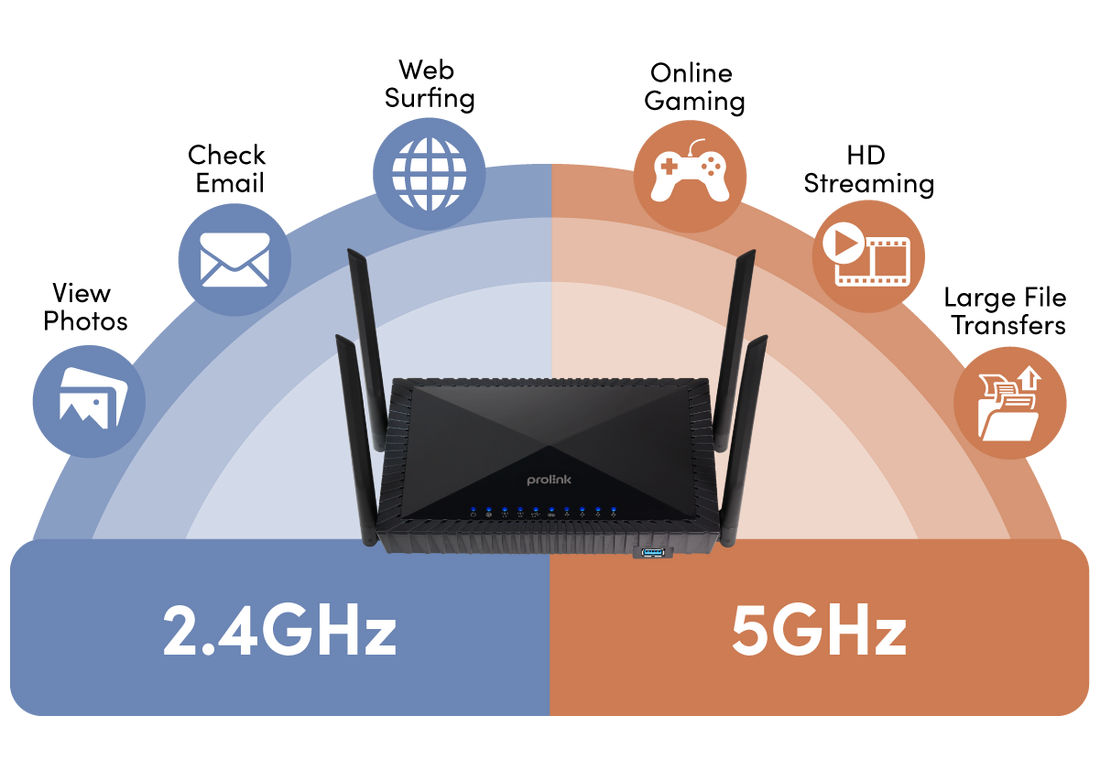What is Dual-Band Technology?
Dual-band refers to a technology used in wireless communication, particularly in Wi-Fi networking. It involves the use of two separate frequency bands to transmit and receive data wirelessly. These frequency bands are 2.4 GHz and 5 GHz.
2.4 GHz Band
- The 2.4 GHz band is the older and more widely used frequency for Wi-Fi. It has a longer wavelength, which means it can penetrate walls and other obstacles more effectively, providing better coverage over longer distances.
- However, because it's a commonly used frequency for various household devices like microwaves, cordless phones, and Bluetooth devices, it's more susceptible to interference, which can lead to slower and less reliable connections.
5 GHz Band
- The 5 GHz band is a higher frequency with a shorter wavelength. While it doesn't penetrate walls as effectively as the 2.4 GHz band, it offers significantly higher data transfer speeds and is less congested.
- Because it's less crowded, devices connected to the 5 GHz band are less likely to experience interference from other devices. This makes it ideal for bandwidth-intensive activities like streaming high-definition video, online gaming, and large file transfers.

Benefits of Dual-Band Technology:
- Faster Speeds for Compatible Devices: Devices that support 5GHz connections can achieve significantly higher speeds compared to those limited to 2.4GHz. This is particularly important for activities like streaming high-definition video, online gaming, and large file transfers.
- Better Coverage in Close Proximity: While the 2.4GHz band has better coverage over longer distances and through walls, the 5GHz band excels in close-range situations. This is especially beneficial for devices in the same room as the router.
- Reduced Interference: The 2.4GHz band is commonly used by a wide range of household devices like microwaves, cordless phones, and Bluetooth devices. Having the 5GHz band available can help reduce interference from these devices, leading to a more reliable connection.
- Increased Bandwidth: The 5 GHz band offers a wider range of available channels, allowing for more devices to connect simultaneously without congestion. This is especially useful in crowded urban environments or offices.
- Seamless Roaming: Some dual-band routers support features like band steering or mesh networking, which enable devices to seamlessly switch between the 2.4GHz and 5GHz bands based on signal strength and load.
- Optimized Network for Multiple Users: Dual-band routers allow you to segregate devices based on their bandwidth needs, optimizing the network for different activities. For example, you can connect devices that require higher speeds, such as gaming consoles or 4K streaming devices, to the 5GHz band. Simultaneously, less demanding devices like smart home gadgets or older laptops can be connected to the 2.4GHz band. This ensures that each device receives the appropriate bandwidth for optimal performance.
- Flexibility and Compatibility: Dual-band routers are compatible with a wide range of devices, whether they support 2.4GHz or 5GHz connections. This ensures that all your devices can connect to the network, regardless of their capabilities.
Overall, the dual-band technology provides a more versatile and efficient way to manage your wireless network, catering to a wide range of devices and activities. It's especially valuable in environments with multiple connected devices and diverse bandwidth requirements.
--
Explore products with Dual-Band technology:
1. Wireless AC2600 Dual-Band Gigabit Router | PRC2401U

2. Dual-band Wi-Fi AC1200 Extender | DH-5201

3. 3MP Home Security Camera | DS-3105

